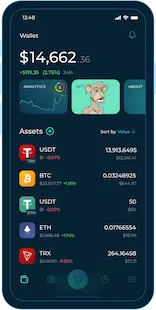Block Explorers (Tronscan, Etherscan, etc) and How to Use Them
Feb 13, 2023In our beginner guide to blockchain we mentioned that transparency is the fundamental value of the technology. At this point, block explorers must be a cornerstone of it. In this blog post, we will discuss what block explorers are, how they can be of use, and how exactly they ensure transparency.
Block Explorer Features
Block explorers are powerful tools for searching, viewing, and tracking data stored on the blockchain. They aggregate public data for a specific chain and display details in a human-readable format to provide the following information:
- Database of all operations
Blockchain scanners track all the past and current activity on corresponding chains so users can see how transactions are moving around the network, how they’re organized in blocks and what computational power require.
| Source: Blockchain.com |
On top of that, these “databases” reveal everything related to existing wallets, balance and transaction history included, without identifying the owner unless the address has been tagged. On that premise, some investors consider having multiple addresses to avoid overexposing.
- Validating tokens & smart contracts
Every cryptocurrency network has its own explorers. You can also find token source codes, usage statistics, top token holders’ wallets, and other essential data there. With these features, crypto users can evaluate the overall health of a particular blockchain.
- Transaction details
Major application of block explorer, however, is to verify the status of crypto operations. It clearly mentions the address that initiated the transaction, the receiving party, and timing. Blockchain viewer, thus, confirms the transfer did take place and functions as a receipt for transacting parties.
How to Read Transactions on Explorers
Here is a vocabulary list that can help you interpret Transaction Attributes.
| Source: Tronscan.org |
Transaction ID, TxID, or Tx Hash – a 64-character long identifier of a transaction that is used to track the operation and view its contents.
Status – shows if the transaction is still pending, confirmed, or has been invalidated by the network.
Block – a collection of transactions that are bundled together and consecutively added to the blockchain.
Block ID/Block Height – the number of the block containing this given transaction.
Size – how many bytes the transaction occupies in the block.
Mempool – a list of unconfirmed transactions not yet added to the block.
How Does My Transaction Get Into The Blockchain?
When initiating a transaction, your device sends out a message containing the necessary information about the transaction to computers running the network ➡ Once the message is sent out, the nodes verify that the sender has enough funds to transfer the amount requested and the recipient address is valid ➡ After a successful verification, the transaction gets its hash and is added to a block.
Due to the open nature of the blockchain, the information is then available for everyone to see on blockchain scanners.
Popular Blockchain Explorers
Most explorers give a similar set of information. The way data is presented may vary depending on the specifics of different chains while some platforms offer a more in-depth view.
- Tronscan helps users easily view the transaction history of any address on the Tron network, check block times and sizes, track daily active users, and other statistics.
- Etherscan allows users to explore blocks and transactions on the Ethereum blockchain. It also provides chain statistic charts and recommended gas prices. Data related to ERC-721(NFTs) and ERC-1155 (hybrid NFTs) also lives here.
| Source: Etherscan.io |
- Bitcoin block scanner Blockchain.com gives insights into a wide range of data related to miners such as their reward for solving blocks and BTC mining difficulty.
- On top of standard information, Solscan for the Solana network shows the speed of the blockchain per second, Solana staking & trading analytics, plus Solana-based NFT stats.
- Blockchair is a multi-chain explorer that supports 17 networks with BNB, Dogecoin, and Dash among them. Not only it provides data for these networks but also enables comparing their stats side by side.
| Source: Blockchair.com |
How to use Block Explorers
Using a blockchain explorer is quite straightforward: copy and paste the wallet address or Tx Hash into the search bar to look up a specific transaction on a given network.
The lowest effort way, however, is to open a transaction history in your wallet. Arctic Wallet apps give links that directly take you to the relevant explorer for each of your transactions.
| Arctic Wallet Android App / Tronscan |
Ultimately, whether you want to track the transaction status, keep track of your cryptocurrency activities, or learn more about how blockchain works, block explorers open the window for you.
Enter the world of crypto together with Arctic Wallet mobile (Android and iOS) and desktop apps and start exploring!


